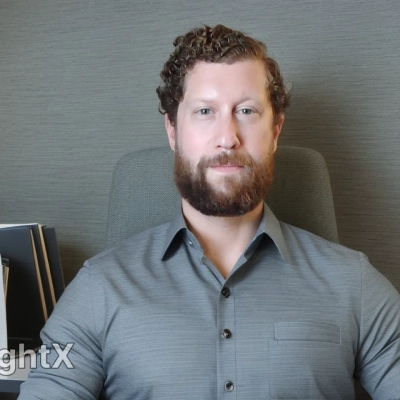7 Tools from Psychologists to Understand and Navigate Emotions
Emotions can be complex and challenging to navigate, but psychologists have developed powerful tools to help. This article explores seven expert-backed techniques for understanding and managing our emotional landscape. From naming emotions to practicing mindfulness, these strategies offer practical ways to enhance emotional intelligence and improve overall well-being.
- Name It to Tame It
- Body Awareness Reveals Hidden Emotions
- Countertransference Unlocks Client Understanding
- Emotional First Aid Heals Psychological Wounds
- Cognitive Reframing Transforms Reactive Thoughts
- Mindfulness Journaling Identifies Emotional Patterns
- Focus on Controllable Behaviors Not Outcomes
Name It to Tame It
For me, one of the most impactful tools I've learned, both as a professional in relational therapy and in my own personal life, is the practice of "name it to tame it." It's a simple concept, but incredibly powerful. When you consciously identify and label what you're feeling, it engages the logical, language-processing part of the brain, which helps calm the more reactive emotional centers.
In my opinion, this practice works because it bridges awareness with regulation. If I notice myself feeling tense or unsettled, instead of pushing it aside, I pause and say to myself, "I'm feeling anxious" or "I'm feeling disappointed." That small act of acknowledgment stops me from spiraling into overthinking or reacting impulsively. It also helps me connect the emotion to its possible trigger, which gives me a clearer sense of what I actually need in that moment.
I use this tool daily, sometimes in quick mental check-ins, sometimes in journaling, because it creates space between the emotion and my response. Over time, it's not just about managing emotions; it's about developing a more compassionate and curious relationship with them. And in my work with clients, I see the same thing happen: when they start naming their emotions, they begin to understand themselves more deeply, which transforms the way they relate to others.

Body Awareness Reveals Hidden Emotions
I use body awareness as a way to understand my own emotions. Sometimes, I can't put a name on how I feel emotionally, but I notice something that has changed in my physical body -- a movement, a posture, discomfort, a contraction, etc. I then trace back from that change to what changed in my environment or my thoughts. I notice that when I think about politics or other stressful topics, my body tenses up and I contract in uncomfortable ways. This body-mind connection is fairly easy to trace, but sometimes I need to spend some time with the physical change and ask it, "What are you trying to tell me?" as though it were a person inside me. This often clarifies what is happening when that sensation talks back to me, like "I'm sad/angry/stressed/lonely," etc.

Countertransference Unlocks Client Understanding
The notion of countertransference or enactment. I often teach clients the same as a therapist would be taught in the psychodynamic or psychoanalytic tradition. We tend to internalize emotion and act on it, rather than exploring truly where it came from including what portion of that emotional was elicited by external sources, namely other people. A supervisee said reflected a client's statement, which elicited tears, and they felt guilty for eliciting this emotion. At the end of the session, the client apologized for crying. The therapist could recognize that maybe emotions were acceptable in the client's background, but didn't intuitively make the leap that their guilt told them more about the client about themselves: was it a coincidence the therapist felt guilt about a client's emotion that the client judges as unacceptable? No, the therapist's guilt was empathy - the felt (empathized with) the clients judgement of their emotion. Rather than internalize this guilt, lets use to understand the client.

Emotional First Aid Heals Psychological Wounds
A great technique I've found incredibly useful is Emotional First Aid, a concept popularized by psychologist Guy Winch. It's essentially about applying the principles of physical first aid to our emotional well-being. When we get a cut, we clean it and put a bandage on it; similarly, when we experience emotional pain—like a setback at work or criticism—we need to address it directly instead of just ignoring it.
I use this tool by first acknowledging the emotional wound without judgment. For instance, if a business deal falls through, instead of dismissing the disappointment, I allow myself to feel it. Then, I actively counter the negative self-talk that often follows. I might ask myself, "Is this setback truly a reflection of my capabilities, or is it a single event with multiple factors?"
This practice helps me to process and move past difficult feelings much more quickly and constructively, preventing emotional wounds from festering and affecting my long-term performance and mental health. It's about being as proactive and compassionate with my emotions as I would be with my physical health.
Cognitive Reframing Transforms Reactive Thoughts
One technique I've found incredibly valuable comes from cognitive behavioral therapy (CBT): the practice of cognitive reframing.
This tool helps me pause and consciously examine the thoughts driving my emotions, especially during high-pressure moments. For example, when facing setbacks in growing PressRoom, instead of immediately defaulting to self-doubt or frustration, I step back to identify the specific thought patterns fueling those feelings. Then, I challenge any unhelpful assumptions by asking, "Is this thought fact-based or just a fear?"
Using reframing regularly helps me stay grounded, reduce emotional overwhelm, and approach challenges with clearer, more constructive perspectives. It's a way of turning reactive emotions into intentional responses.
Emotions are data, not destiny. Cognitive reframing teaches us to interpret that data wisely and lead with greater emotional intelligence.

Mindfulness Journaling Identifies Emotional Patterns
One tool I've learned from a psychologist that has helped me understand my emotions better is mindfulness journaling. I started using it during a stressful period in my life. The technique involves writing down my thoughts and feelings each day, focusing on what triggered my emotions, how I reacted, and how I could respond differently next time. This practice has helped me identify patterns in my emotional reactions, allowing me to address issues before they escalate. I use it every evening, reflecting on my day and checking in with how I'm feeling. It's been an eye-opener in recognizing the underlying causes of my stress and anxiety, and it's helped me manage them more effectively. By consistently using this tool, I've gained better control over my emotional responses and developed healthier coping strategies.

Focus on Controllable Behaviors Not Outcomes
One valuable technique I learned from a psychologist is to focus on setting expectations around controllable behaviors rather than uncontrollable outcomes. This approach has significantly improved my emotional well-being by shifting my self-worth from being results-based to being grounded in keeping promises to myself. I apply this tool daily by celebrating the consistent actions I take rather than fixating on outcomes that may be influenced by external factors. This mindset shift has transformed my relationship with myself and how I process both success and disappointment.



